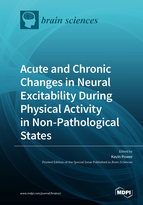Acute and Chronic Changes in Neural Excitability During Physical Activity in Non-Pathological States
A special issue of Brain Sciences (ISSN 2076-3425). This special issue belongs to the section "Systems Neuroscience".
Deadline for manuscript submissions: closed (9 December 2019) | Viewed by 25062
Special Issue Editor
Interests: neurophysiology; neuroplasticity;cortical excitability;spinal excitabilty; exercise; fatigue
Special Issue Information
Dear Colleagues,
The neural control of human motor output and how it is modified by alterations in physical activity levels is complex and multidimensional. The use of various experimental designs has vastly increased our knowledge of how the nervous system integrates descending, segmental, and ascending information to produce motor outputs, yet there is still much to learn. A more complete picture of how the neurophysiology underlying the control of human motor outputs may prove useful in guiding rehabilitation programs aimed at reducing motor impairments following disease or injury is emerging.
The purpose of this Special Issue is to collect original articles that explore neural excitability in various states. Studies examining neural excitability on a moment-to-moment basis (acute) or following prolonged periods of exercise or skill training and disuse (chronic) are encouraged. Original research studies using various experimental measures (e.g., transcranial magnetic stimulation, transmastoid electrical stimulation, single motor unit recordings, electroencephalography, and measures of spinal reflexes), in various states (e.g., fatigued, non-fatigued, and resting) during different types of motor outputs (tonic or dynamic) are encouraged. Experimental studies and literature reviews are welcome.
Dr. Kevin Power
Guest Editor
Manuscript Submission Information
Manuscripts should be submitted online at www.mdpi.com by registering and logging in to this website. Once you are registered, click here to go to the submission form. Manuscripts can be submitted until the deadline. All submissions that pass pre-check are peer-reviewed. Accepted papers will be published continuously in the journal (as soon as accepted) and will be listed together on the special issue website. Research articles, review articles as well as short communications are invited. For planned papers, a title and short abstract (about 100 words) can be sent to the Editorial Office for announcement on this website.
Submitted manuscripts should not have been published previously, nor be under consideration for publication elsewhere (except conference proceedings papers). All manuscripts are thoroughly refereed through a single-blind peer-review process. A guide for authors and other relevant information for submission of manuscripts is available on the Instructions for Authors page. Brain Sciences is an international peer-reviewed open access monthly journal published by MDPI.
Please visit the Instructions for Authors page before submitting a manuscript. The Article Processing Charge (APC) for publication in this open access journal is 2200 CHF (Swiss Francs). Submitted papers should be well formatted and use good English. Authors may use MDPI's English editing service prior to publication or during author revisions.
Keywords
- Neurophysiology
- Neuroplasticity
- Cortical excitability
- Spinal excitability
- Exercise
- Fatigue







